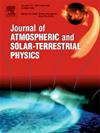Aerosol radiation characteristics based on Himawari-8 and AERONET in Beijing city
IF 1.8
4区 地球科学
Q3 GEOCHEMISTRY & GEOPHYSICS
Journal of Atmospheric and Solar-Terrestrial Physics
Pub Date : 2025-01-01
DOI:10.1016/j.jastp.2024.106411
引用次数: 0
Abstract
Aerosol radiative forcing (ARF) is an important parameter that describes the impact of atmospheric aerosols on the earth-atmosphere radiation balance. This parameter holds significant importance for environmental monitoring and understanding climate change. Aerosol optical depth (AOD) reflects the degree of atmospheric pollution and plays a key role in evaluating ARF. In this paper, the Second Simulation of a Satellite Signal in the Solar Spectrum (6S) is utilized to calculate the ARF in different AOD in Beijing. The variation characteristics of ARF at different time scales are also studied. Meanwhile, the characteristics of ARF under different cloud types are analyzed, and the coupling relationship between cloud parameters and ARF is proposed. The results show the ARF of absorptive aerosol is comparable to that of fine-mode aerosol, while coarse-mode aerosol have the minimum ARF. The ARF varies significantly under different cloud types. The ARF varies from −59.18 ± 11.64 W/m2 to −104.52 ± 20.90 W/m2 at the bottom of atmosphere (BOA), from −9.94 ± 1.99 W/m2 to −27.41 ± 4.11 W/m2 at the top of the atmosphere (TOA), and from 49.24 ± 9.85 W/m2 to 77.11 ± 15.42 W/m2 at the atmosphere (ATM). The results also show a strong correlation between cloud optical thickness and ARF among cloud parameters. This paper contributes to a deeper understanding of aerosol-cloud interactions in the earth-atmosphere system and is important for predicting future climate change.
基于himawai -8和AERONET的北京地区气溶胶辐射特征
气溶胶辐射强迫(ARF)是描述大气气溶胶对地球-大气辐射平衡影响的重要参数。该参数对环境监测和了解气候变化具有重要意义。气溶胶光学深度(AOD)反映了大气的污染程度,是评价ARF的关键。本文利用卫星信号在太阳光谱的第二次模拟(6S)来计算北京地区不同AOD的ARF。研究了ARF在不同时间尺度上的变化特征。同时,分析了不同云类型下ARF的特征,提出了云参数与ARF的耦合关系。结果表明,吸收型气溶胶的ARF与细模气溶胶相当,而粗模气溶胶的ARF最小。不同云型下的ARF有显著差异。大气底部(BOA)的ARF变化范围为−59.18±11.64 W/m2 ~−104.52±20.90 W/m2,大气顶部(TOA)的ARF变化范围为−9.94±1.99 W/m2 ~−27.41±4.11 W/m2,大气顶部(ATM)的ARF变化范围为49.24±9.85 W/m2 ~ 77.11±15.42 W/m2。结果还表明,云的光学厚度与各云参数之间的ARF有很强的相关性。这篇论文有助于更深入地了解地球-大气系统中气溶胶-云的相互作用,对预测未来气候变化具有重要意义。
本文章由计算机程序翻译,如有差异,请以英文原文为准。
求助全文
约1分钟内获得全文
求助全文
来源期刊

Journal of Atmospheric and Solar-Terrestrial Physics
地学-地球化学与地球物理
CiteScore
4.10
自引率
5.30%
发文量
95
审稿时长
6 months
期刊介绍:
The Journal of Atmospheric and Solar-Terrestrial Physics (JASTP) is an international journal concerned with the inter-disciplinary science of the Earth''s atmospheric and space environment, especially the highly varied and highly variable physical phenomena that occur in this natural laboratory and the processes that couple them.
The journal covers the physical processes operating in the troposphere, stratosphere, mesosphere, thermosphere, ionosphere, magnetosphere, the Sun, interplanetary medium, and heliosphere. Phenomena occurring in other "spheres", solar influences on climate, and supporting laboratory measurements are also considered. The journal deals especially with the coupling between the different regions.
Solar flares, coronal mass ejections, and other energetic events on the Sun create interesting and important perturbations in the near-Earth space environment. The physics of such "space weather" is central to the Journal of Atmospheric and Solar-Terrestrial Physics and the journal welcomes papers that lead in the direction of a predictive understanding of the coupled system. Regarding the upper atmosphere, the subjects of aeronomy, geomagnetism and geoelectricity, auroral phenomena, radio wave propagation, and plasma instabilities, are examples within the broad field of solar-terrestrial physics which emphasise the energy exchange between the solar wind, the magnetospheric and ionospheric plasmas, and the neutral gas. In the lower atmosphere, topics covered range from mesoscale to global scale dynamics, to atmospheric electricity, lightning and its effects, and to anthropogenic changes.
 求助内容:
求助内容: 应助结果提醒方式:
应助结果提醒方式:


